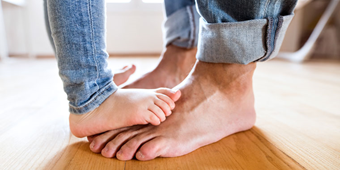Relieve the Pinch Of Cubital Tunnel Syndrome

Find Your Perfect Match
Answer a few questions and we'll provide you with a list of primary care providers that best fit your needs.
That tingling or numbness that runs down your arm, from the elbow to the pinky and ring fingers? That could be a sign of a condition called cubital tunnel syndrome.
This sensation may come on after you’ve been talking on the phone for a long period, with your elbow bent. And this tingling may be enough to wake you in the middle of the night, after you’ve fallen asleep, with your elbow bent.
The connection between a bent elbow and the tingling and numbness, explains hand surgeon Matthew Cavo, MD, is that the ulnar nerve is getting pinched in the elbow joint. That’s why the condition is also known as ulnar nerve entrapment. Cubital tunnel syndrome can also be brought on by trauma to the elbow joint, which increases pressure on the nerve.
Dr. Matthew Cavo explains the cause of the tingling and numbness of cubital tunnel syndrome.
Click play to watch the video or read video transcript.
The condition is similar to carpal tunnel syndrome, which also involves a pinched nerve. In this case, the median nerve at the wrist. The numbness caused by carpal tunnel occurs in the thumb side of the hand.
Carpal tunnel occurs more commonly than cubital tunnel syndrome and is more likely to be treated with surgery, Dr. Cavo says.
Who Is At Risk Of Cubital Tunnel Syndrome?
While the condition can occur in people in any profession, it’s more common in those whose work requires long periods on the phone, such as receptionists and telemarketers. Or for anyone whose work requires them to keep their elbows bent for a long period of time.
While trauma to the elbow can bring on cubital tunnel symptoms, repetitive use of the elbow is more often the cause as it can increase pressure on the ulnar nerve.
Symptoms And Diagnosis Of Cubital Tunnel Syndrome
The tingling and numbness mentioned previously are commonly the first noticeable symptoms of cubital tunnel syndrome. Cubital tunnel can affect your dominant or nondominant hand. “It just depends more so on which nerve is getting pinched, for a longer period of time,” Dr. Cavo says.
“Later, symptoms of more of a chronic nerve compression result in weakness in the hand, weakness in the grip, and weakness in pinch strength.”
You may occasionally experience numbness from sleeping the wrong way. That’s normal. But with cubital tunnel syndrome, the symptoms are more frequent and persistent.
Dr. Cavo explains that the following may indicate you should be examined for cubital tunnel syndrome: “When patients are being woken up multiple times per night, from their deep sleep, or they're having more and more difficulties at work maintaining a certain posture. Or if they're starting to get some weakness in their hand, is when it's the more concerning symptom.”
A cubital tunnel syndrome diagnosis is made based on your history, how often you experience symptoms, which fingers are affected, and a physical exam by a hand surgeon or primary care physician.
To confirm the diagnosis, your physician may refer you for an electromyogram (EMG), which is a nerve study that tests how well and fast your nerves work.
Nonsurgical Treatment For Cubital Tunnel Syndrome
Following through with prescribed treatment for cubital tunnel syndrome is important. The condition can worsen and the numbness can become permanent, Dr. Cavo warns. “And the weakness that people experience in their hand often progresses and can lead to complete atrophy of multiple muscles in the hand.”
Your doctor will recommend nonsurgical options for treating mild to moderate cubital tunnel. Dr. Cavo explains that these include:
- Avoiding trauma to the elbow. This can be accomplished through activity modification or using an elbow pad to cushion the joint.
- Occupational therapy and hand therapy. Therapists can help you learn new ways to complete your work while lessening pressure on the ulnar nerve. They can also help you adopt the proper posture to avoid further pressure on the nerve.
- Bracing your arm. This will help you keep your arm in a straight position at night and during the day to take pressure off the nerve.
Dr. Matthew Cavo explains nonsurgical options for treating cubital tunnel syndrome.
Click play to watch the video or read video transcript.
Premier Health hand therapist Krista Storms, OT, adds that therapists instruct cubital tunnel syndrome patients to avoid bending their arms when talking on the phone. “We talk about not resting on their elbows. And often they are waking up at night with symptoms, so we make them a splint that blocks their elbow flexion and lets the nerve rest.”
Surgical Treatment For Cubital Tunnel Syndrome
When nonsurgical treatment doesn’t relieve your symptoms, your physician may recommend surgery. Particularly if the numbness and tingling persist or worsen and your affected hand weakens.
The surgical procedure for cubital tunnel syndrome is called ulnar nerve release.
What it involves is a fairly small incision on the inside of the elbow, releasing the pressure that is causing the problem on the ulnar nerve,” Dr. Cavo explains. “This is a fairly fast recovery time period, where we really are just waiting for the skin to heal.” While recovering, patients can move their elbows, as they are neither splinted nor casted. “They're able to complete a lot of their activities of daily living, even during the early recovery process,” Dr. Cavo says.
Dr. Matthew Cavo talks about surgery for correcting cubital tunnel syndrome.
Click play to watch the video or read video transcript.
Find Your Perfect Match
Answer a few questions and we'll provide you with a list of primary care providers that best fit your needs.
Source: Matthew Cavo, MD, Hand and Reconstructive Surgeons and Associates; Krista Storms, OT; American Academy of Orthopaedic Surgeons








